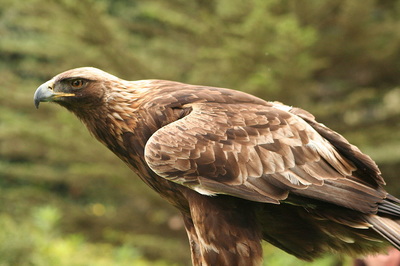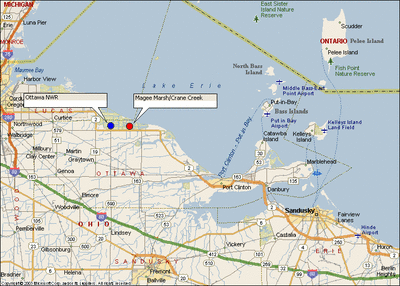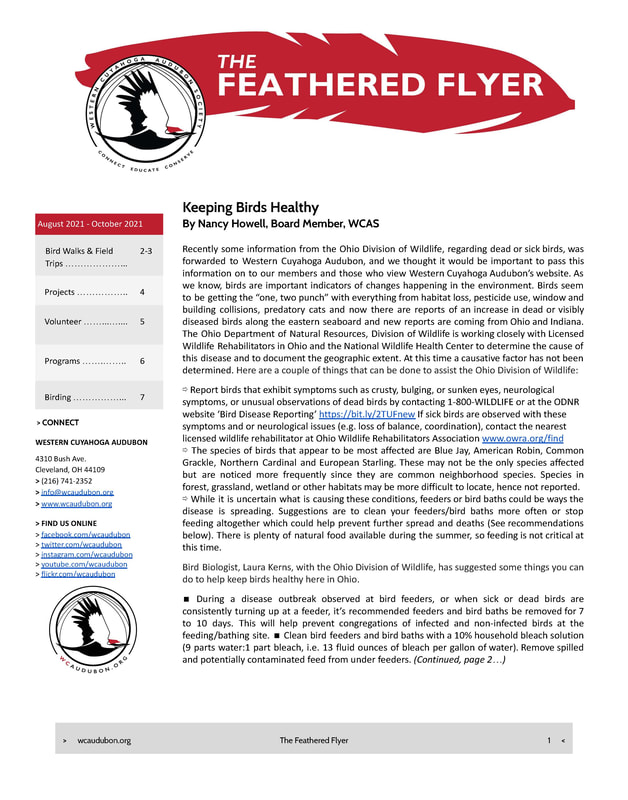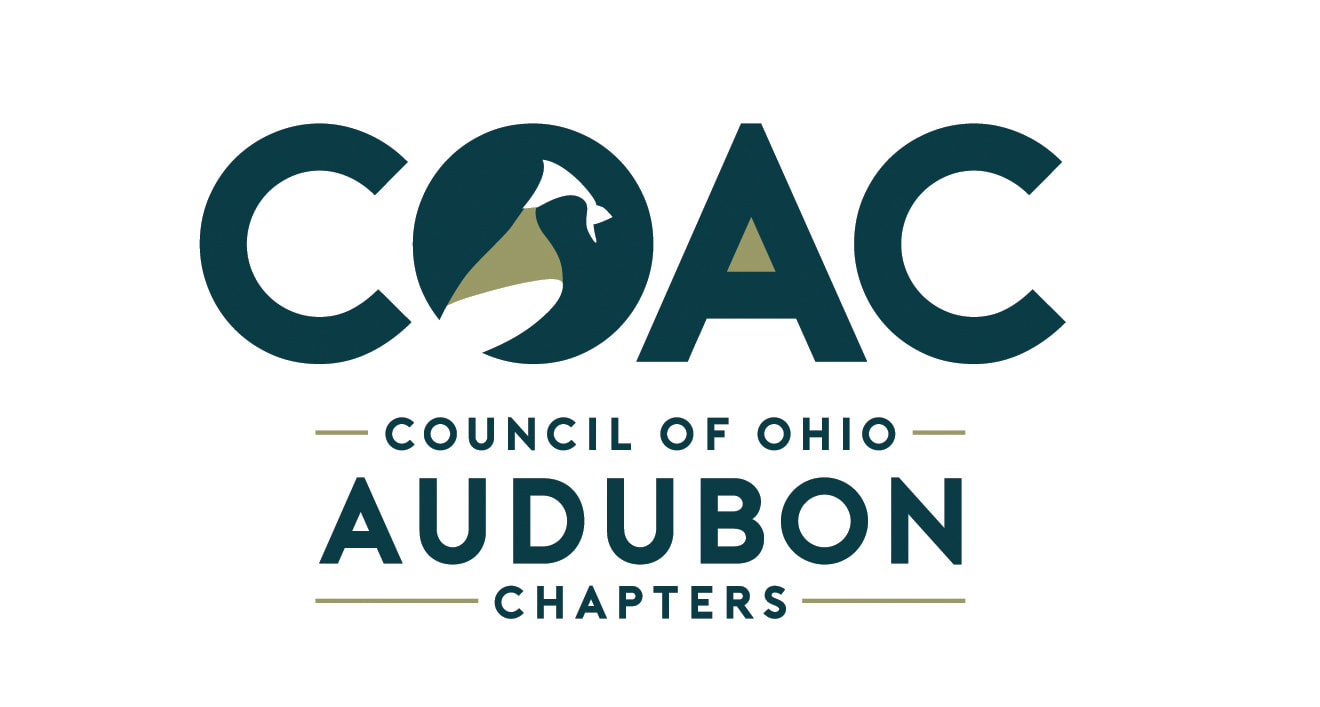A conversation with Western Cuyahoga Audubon Second Saturday Bird Walk Leaders, Bill Deininger, Ken Gober and Dave Graskemper Part One: Second Saturday Bird Walks Share Lifelong Passion
Bill Deininger: Hi, I’m Bill Deininger, one of the bird watchers, leaders, down in the Metroparks. Been doing this for about forty years. It has become my passion to bird watch, my obsession, my therapy, however you want to look at it. When I’m out birding, I don’t care about my family, my wife, my kids, my bills, my work - it’s just total relaxation and this is pretty much just for me. I love to share birding with people, we help teach and lead walks with my other two compadres here, and we enjoy what we do.
[00:00:43] Ken Gober: Hi, my name is Ken Gober. I am retired from Cleveland Metroparks, I was there for nearly thirty-eight years, the last twenty-five years of so as manager of the Rocky River Nature Center. I’ve been birding, golly, I started in college with an Ornithology course and have just enjoyed it ever since. Started a few bird walks as I was working at the Nature Center. I think that’s where I met these guys and just enjoying it in my retirement. [00:01:20] Dave Graskemper: Dave Graskemper. One of the leaders on the monthly Saturday morning with the birds. I’ve been birding from a very, very young age starting before I was even ten years old birding back in the woods of my parents back yard. I would be back there with my binoculars and Golden Field Guide and birds by myself. It was something I got hooked on at a young age. I asked my Father to take me down to some bird walks in the Metroparks. They used to have bird walks over at Mastick Road Picnic Area for a number of years. He would take me down there for a number of years until the walks were discontinued at some point and I started to come to the walks here at Rocky River and that’s where I met Ken and Bill. I’ve been birding for about forty years and just like these two guys, it’s an absolute love and passion and something I really enjoy and something I enjoy sharing with other people especially people that are new to the hobby. Sometimes we get people down here who are regulars and they’ve seen birds before and they’re used to it. But to get someone new and they see something for the first time and you see their excitement, that’s something I really enjoy sharing with people.
Above: Second Saturday Bird Walk July 2016 photos by Betsey Merkel. Explore the complete Flickr album here.
Of course, I enjoy birding with these two guys as well, great friends through the years. We always say, “Even if the birding is bad, the company is always good!” To follow up with what Bill said, it is very therapeutic. You really forget the rest of the world for a couple of hours and especially now, in this day and age, you can reconnect with nature and with people. I think a lot of people, with the social media stuff, aren’t connecting with people on a personal level much anymore and I think birding, maybe, helps getting connected not just with people, but with nature.
[00:03:46] Ken Gober: You know, both these guys mentioned “sharing” and I don’t know if I mentioned that or not, but that is very important for me as well. And that’s true in everything I do. I just came back from a trip to Alaska. Everytime I see something, I always turn around and look, “Who can I share this with?” - and try to find somebody to share it with. I think that’s one of the important things for me in leading these bird walks. [00:04:18] Bill Deininger: Yes, there’s nothing like being out in the field all alone and seeing no one else to say, “Look!” There’s just me looking at it and I wish many times there were people to see what we can see. Even at my age, I still get very excited when I see something unusual or rare. We go chasing birds, we don’t just do it locally. We go all over Northeastern Ohio to find and locate birds. Part Two: A Tale of Natural Wonder
[00:04:18]
Ken Gober: I’ll talk a little bit about Alaska, if you want, it’s my favorite place away from home. I’ve been there more than thirty times. I’ve been all over the state. My most recent visit was to the northern part. I spent a little bit of time in the Fairbanks, Denali area but my real excitement for this trip was a visit to the Arctic National Wildlife Refuge, way up above the Arctic Circle, where there’s twenty-four hours of daylight and the sun never set. That was amazing and it’s hard to recover from that! I’ve wanted to, for the longest time, go up to the “ANWRs” they call it, and see the Porcupine Caribou herd. ANWR is known for the controversy over oil and oil drilling, and there’s a portion of that’s been reserved, and there’s people on both sides (of the controversy). I wanted to go see it for myself and I hit it on the head. We saw probably one hundred thousand caribou. It was just incredible. We looked on the map, we could look in front of us and we could see the mountains, and on the map we figured there were fifteen miles of Caribou in front of us. And who knows how far they went beyond the mountains because we couldn’t see. Dave Graskemper: Was this a migration for them?
Images from left to right: Arctic National Wildlife Refuge (ANWR), Snowy Owl, and Golden Eagle. For slideshow, click/tap image any image corner. Use social media icons to share.
Ken Gober: Yes, this was the spring migration of the Porcupine Caribou herd. We saw a Snowy Owl as well. We didn’t see the nest but this was up on its nesting territory. In fact, I know there was a nest nearby, the bird was perched on it’s little hummocks. You always read about that, but I actually got to see it. And a Golden Eagle flew by, and it took off to protect its territory, to chase off the Golden Eagle. That was cool. A lot of fun!
[00:07:00] Bill Deininger: As you can see we still get excited about birds that we see. In fact, I get so excited, I’ve been taping birds with my video camera. I tape them and unlike these guys, I can go home at night and watch birds again and again. It’s something I enjoy doing and I have shared that with numerous groups and clubs: the Kirtland Bird Club, Western Cuyahoga Audubon Society and a few other places. Not only do I enjoy watching them in the wild, I enjoy taping them, editing them, and rewatching them. If you can’t sleep at night, put some birds on! I enjoy that very much. [00:07:39] Ken Gober: If you ever have a chance to see one of his presentations, do it. “Birding with Bill Without Binoculars”? Bill Deininger: “Birding Without Binoculars With Bill”, that’s what my title is. Ken Gober: And it’s great. Not only does it have some great video in it, but good humor. A lot of fun! Bill Deininger: It’s fun to do. Fun to make, fun to watch, fun to edit. So, in addition to coming down to looking at birds in the field, I watch them at home too. Bill Deininger: I don’t know if you noticed, but we just edited so we could go check a bird that was flying over there in the trees behind us. We’re that obsessed! Part Three: Memorable Bird Walk Stories
[00:08:14]
Dave Graskemper: We were discussing the previous bird walks that were memorable and the one that comes to my mind recently is the January walk, not from this past winter, but two winters ago, I believe it was the January walk and it was -1°F when we started. Not surprisingly, nobody showed up except the three of us! I remember standing in the parking lot with pins and needles on my face from the cold and thinking, “There’s no way this is going to happen. We’re not going anywhere.” It was one of those situations where we basically said, “Okay, we’ll walk so far, and if we’re still alive, we’ll continue on with the walk.” And that’s what we did. One thousand feet at a time kind of situation. We ended up doing the entire walk, it took us a couple of hours and it turned out not to be such a bad day as far as birding goes. It was a kind of attrition type of thing to see if we could really do it! And also, obviously, to give some grief to the other birders, who didn’t come, in the upcoming months and to let them know to get out of bed and join us next time! We had a really good day.
Above: Hoover over the image for details. Click/tap any image corner to enlarge. Use social media icons to share. Visit Western Cuyahoga Audubon Flickr Albums to see more photos.
Bill Deininger: Didn’t we see the fox that day? We saw a fox, a great view of the fox.
Dave Graskemper: He was following us up along the ridge and he was in his winter coat. A huge, big fox. So, that was one of the memorable walks. Bill Deininger: The point there too is that we lead walks every second Saturday of the month regardless of the weather we’re out there sunshine, rain, cold, winter...and I, and I’m sure they still do, enjoy it. We have no problem with the weather. It’s a reason, I tell my wife, I have to get out of the house. She asks, “Aren’t you going to be cold?” And I say, “I have winter clothes. I have enough to keep me warm.” Someone said, “It’s never bad weather, it’s bad clothing.” This is a year-round activity for us, relatively inexpensive once you have your gear, and it’s just getting to where you have to go. You can bird anywhere, everywhere. Ken, just went up to Alaska! So, wherever you go, there are birding activities. In fact, when we go on vacation, I tell my wife, “My binoculars go in the car before you do.” Obviously, humor, and she understands that. But again, it’s something we can do all the time and I do it all the time. In fact, I came down here an hour before this interview to walk around to see what’s out there. Dave Graskemper: Bill’s hard core. I like birding, but Bill loves birding! Every waking moment he’d be out there if he could. Almost every waking moment. I’m not quite at that point, but it is something I enjoy very much. Really, when I think of it, it’s funny. Like what you were saying about getting out of bed with the weather. To get out of bed, to do anything in the morning for me is a chore. Especially, getting up for work! But we’ll go to Magee Marsh in the spring and I have to be up at four AM in the morning to meet people at five-thirty to get out there at seven AM. I jump out of bed like it’s the first day of vacation! It’s amazing, if you enjoy something it’s not a problem to get out early to go do it. [00:11:43] Bill Deininger: And we go to four, five, six o’clock at night too before we start our hour and half drive home. It’s a long day. Dave Graskemper: It’s something we’ve been doing for a long time. Not thirty years, but fifteen years. Bill Deininger: And we still love it, we still enjoy it and can’t wait until May comes around. Dave Graskemper: We all start talking around mid-April, “Can you get this Friday off?” We’ll usually get a car load of people, not just Bill and I, but with several other groups of people. This past year the first one (trip to Magee Marsh) wasn’t that good but the second one was. But it is always a good time. And the drive up is fun! Bill Deininger: The people we meet up there, you’d be surprised how many local residents are up there for the hour and a half drive west of here. It’s not just us, there are a lot of other people going birding. [00:12:44] Ken Gober: I remember another bird walk during bad weather - birding in bad weather I guess we could call it - story. It was actually during the Sunday morning spring walks. It was just a horrible morning. It rained, and I think it even snowed a little bit and again, it was just the leaders that showed up. But we went on the walk, and had a surprisingly good morning. In fact, the highlight of the morning, and that we told folks about for weeks to come, was the Bittern. Remember the American Bittern? We all got a really good look at it. In the rain, but it was right there. Again, sorry that others missed it but we had a great time. Bill Deininger: Weather doesn’t bother us. You just have to be prepared for it. Part Four: The Backstory on Second Saturday Bird Walks
[00:13:44]
Ken Gober: Well, right now, we’re co-leading the Second Saturday Bird Walks sponsored by Western Cuyahoga Audubon Society and it’s really an extension of a monthly walk that I started called, Monthly Morning With the Birds, when I was still working at the Rocky River Nature Center. Once I retired, it really wasn’t picked up by the staff at the Nature Center, so and I’m not sure how it all got started or did the three of us all get together? Bill Deininger: We enjoyed it so much, we said, let’s not stop this just because Ken’s retiring. So we enjoyed it so much, we said we’re coming here again. Dave Graskemper: I was explaining that to Betsey on the way over here, I couldn’t remember who got the ball rolling and organized through the Audubon Society. Bill Deininger: I don’t recall either, but somehow Penny (O’Connor) jumped in and said, “Let’s do this!” Ken Gober: Then we decided to make it the same Saturday each month so people could depend on it and Second Saturday Bird Walk is how it got started. Part Five: Second Saturday Bird Walks
[00:14:45]
Bill Deininger: These Saturday walks are open to anybody who wants to come. You don’t have to be an experienced birder. In fact, we enjoy the beginners so we can help them and show them what it’s about. It’s always good to see some nice little nine or ten year old with their Mom excited about seeing a bird. We help them whenever we can. All you have to do is come, bring a pair of binoculars if you can. Sometimes we have a spare and sometimes we don’t. Then we walk around the Rocky River Nature Center trails. We have a standard regular route that we go on continuously. Please come. By the way, all these statistics go into eBird and I’m not sure what they do with them once they’re in eBird. I’m sure they’re recorded somewhere. We do a little bit of good in the sense of seeing what kind of birds are out there for statistic purposes. Ken Gober: And that’s available to anybody who wants to either look at it or do some research. We have scientists who use that information. Bill Deininger: Also, anybody, please come down, we’d love to have you join us. We do it (Bird Walks) every second Saturday regardless of the weather. Always at nine AM regardless of the weather. We’ve had as many as four or three people on a walk in the middle of the winter, and I wonder what our maximum was, probably twenty, twenty-five, thirty, in the warm months. Please come down and enjoy this. Dave Graskemper: Depending on how the birding is, it can be anywhere from two and a half hours or or more. On a really good day, three and a half hours. But there’s no obligation to stay with the group. Some people may feel obligated to stick around and that’s not the case. If you get tired after a couple of hours, you’re more than welcome to head out. After the walk we do a count of the species and the number of each species that we saw and those are the numbers that go into eBird for records. Ken Gober: Not only do we see nice birds, but you could end up making some really nice life long friends. Bill and Dave: Yes! Dave Graskemper: Speaking about the people that come down, people that we’ve known for many, many years, which is why I’m glad these walks continue. I think a lot of the people that were coming down for the Monthly Morning Birds were upset that the series of walks was being discontinued. They were very happy to see that we started up with a monthly walk. It’s getting together with friends once a month and having a really good time regardless of how the birding is. It’s always a good time. Bill Deininger: Yes, fun, relaxing. Something I like to do. Please come and join us. You’re welcome. We will help you if you don’t know birds we will help you with what’s out there. We will try and teach you and make sure you see as many birds as you can. It’s the hard core birders all the way down to the very novice birder. Please come! Part Six: Second Saturday Bird Walks Birding
[00:17:58]
Bill Deininger: We see a lot of different birds here. There are a core group of birds that stay here all year. The ones that we like are the migrants that usually come in end of April beginning of May. We can get up to eighty different species in a nice spring morning walk. So please come and join us. There are also a lot of core birds that we see all the time that are regulars and I think the people next to me will name a few, won’t you fellas? [Laughter] Ken Gober: And the year-round residents are Chickadees, Nuthatches, Titmice, Robin, Cardinal, Woodpeckers. Dave Graskemper: And we can occasionally hand-feed birds along the trail. Which is something the kids, especially, really enjoy. Bill Deininger: I still enjoy doing that! And you, you’re always doing that! Dave Graskemper: We can occasionally hand-feed Chickadees, Titmice, White-breasted Nuthatches, and occasionally Red-breasted Nuthatches when they’re in town. We enjoy seeing the more rare birds and especially in the spring when the migration’s coming through and any given morning anything is possible to see. I haven’t seen them in a while, but occasionally the warbler hybrids… All: Lawrence’s, Brewster’s… Dave Graskemper: I haven’t seen Lawrence’s, but I have seen Brewster’s in the past. Bill Deininger: What did we just have down here two or three months ago? The Rough-legged Hawk, which we had never seen before. Dave Graskemper: That’s right, a Rough-legged Hawk. They’re usually up by the airport and one of them happened to drift south, and we got a good look at him which was a… Bill Deininger: Yes! We had trouble identifying him! Because, “What is this?” This bird’s never here! And then sure enough, we figured it out. Most of the birds we see, we know what they are because they’re always here. So, when we get a rare visitor, we have to look very carefully. Bill Deininger: Yes. Things like the Chickadees, Titmice, and Nuthatches...those are common year-round residents. We might see twenty, thirty, of them and I’m sure we haven’t seen them all. They’re quite common. But I remember seeing one a few years ago, in the spring migration, the Worm-eating Warbler. And as far as I know, that is the only one that we’ve had down here. Dave Graskemper: Yes, in all the years we’ve been down here, that’s the one and only time. That’s the contrast that you have between the rare birds you might see once in a lifetime, and the things like the Chickadees and Titmice you’ll see a number of every single time. Bill Deininger: And I still look at that same place every time we walk by in the spring hoping it comes back, but it’s never been there. Dave Graskemper: Also, not just the different types of birds, but sometimes you see something exciting like a Red-tailed Hawk coming in and grabbing a gosling from under the mother. This was exciting for me, upsetting to others obviously. Also, a few years back we had a Barred Owl grab a Chipmunk and bring it back to it’s young right along the trail and we all got a good look at that. So, not rare birds, but common birds doing pretty neat things and that’s always exciting as well. Bill Deininger: Last month we had a Red-headed Woodpecker fly over which is kind of unusual. Part Seven: Rocky River Reservation Geology and Topography
[00:21:31]
Ken Gober: Rocky River Reservation, is one of several reservations in the park, and it’s a little bit unique in that it’s a long, narrow park, it follows the Rocky River Valley, the Rocky River. From its beginning in Lakewood, all the way down to Berea, Ohio it’s about twenty miles plus or minus. It stretches a long way, not necessarily real wide throughout its course but it’s a very interesting valley. There’s some interesting glacial history here. The three golf courses in the Valley are built in the widest part of the valley because that was where the glaciers left behind all the till that eroded very, very easily, relatively speaking, over by the Rocky River over the last ten, twelve thousand years or so. But then you get to portions north and south of that and the Valley kind of pinches and it’s not as wide because it’s more bedrock, Chagrin shale, Berea sandstone and things like that. And, you have a great look at the Berea Falls in Berea, Ohio. It really does offer a variety of habitat and choices for seeing different kinds of birds and wildlife. Part Eight: What Makes a Good Bird Walk?
[00:23:00]
Dave Graskemper: A good bird walk, for me, is a nice comfortable morning in May at the height of the migration and we get a lot of people down here and the weather’s real nice. It’s, I think, sometimes the expectation of the day of what you can possibly see and again, sharing the experience with others. A lot of the people who come are regulars. It’s a group of friends getting together and enjoying a common interest, a common passion. For me, a good day is enjoying good weather and good birding with a lot of good friends. Ken Gober: A nice list of birds is always nice as well. But that’s not really a requirement, I think Dave hit it on the head. Bill Deininger: Even if we don’t see birds, the camaraderie between us and the other people around us, trying to help them...and I’m not sure if we’ve ever had a bad person on a bird walk. You always hear that, “One bad apple in the barrel…” I don’t think we’ve ever had one. It’s always been good people with the same goal of finding birds. Sometimes the people are just as enjoyable as the birds - sometimes! Part Nine: What Do You See for the Future?
[00:28:24]
Ken Gober: Well, I hope one of the things that this walk accomplishes, is to introduce younger folks to take an interest in this and carry on into the future because we’re not going to be here forever. Just like others who have passed this along to us, Mike Stasko, Owen Davies, and all the others, I hope we can pass that on to others. People won’t appreciate and protect things if they don’t see it and understand it and realize what’s there to protect. I’ll share a little story with you that was a little startling to me. A few years ago, with the advent of computers, technology, and all that kind of thing, I saw a DVD available in a bookstore about swamps and all the things that live there. The startling thing to me was that on the cover of the DVD it said, “Better that the real thing.” Bill Deininger: No way! Ken Gober: It isn’t. And if that’s the attitude we take, then the only thing we’re going to have is the history of these things on DVD and videos and pictures, and we’re not going to have the real thing. I hope that what we do sparks an interest and appreciation in people that, in the long run, will protect these things because Lord knows that it’s all experiencing a lot of pressure to be developed, to change. Dave Graskemper: Watching a DVD is obviously not the same experience as being out in the real world. Obviously, it’s just a marketing ploy. That seems to be the way the younger generation is. They’ve got Facebook and they’ve got all these, and everything seems to be on computer these days. I’m hoping we get more young people out here. It seems to me that we usually get middle-aged folks and up coming on the walks, not too many young people, which is disappointing. Maybe this will help get some young people down here, because like Ken said, I think it’s very important that young people get involved in this hobby for the very reasons he stated so that going forward there can be conservation efforts to preserve these areas. Hopefully, going forward we can get some younger people down here. There was a young lady down here and I haven’t seen her this year but she was here with her mother a few years ago. We were all commenting about how knowledgeable she was and she really seemed to enjoy it. We need to have more people down here like that. Bill Deininger: There are some things out there like the Young Birders Club, but we’d certainly like to see more come down here with us. They were down at a walk one time, weren’t they Dave? Dave Graskemper: Yes, they had an event at the Rocky River Nature Center and I helped lead a walk for them. They were from all over the country. A big group of people from all over, yes, you’re right. There are young birders clubs. Bill Deininger: We need more.
Above: Western Cuyahoga Audubon Bird Walk Leaders Dave Graskemper, Bill Deininger, and Ken Gober on July 9, 2016 at the Cleveland Metroparks, Rocky River Reservation, 24000 Valley Pkwy, North Olmsted, OH 44070. Photo by Betsey Merkel.
Store: Tres Amigos de Observación de Aves-Three Friends Birding (PDF)Watch on YouTube: Tres Amigos de Observación de Aves-Three Friends Birding
Make A Donation to Western Cuyahoga Audubon. Your gifts guarantee chapter activities, programs and research continues to reach members and connect birding conservationists around the world. Use our safe and secure PayPal payment button below to make a donation of any amount you choose. All donations are gratefully received.
Comments
|
Story BlogThe Feathered Flyer blog publishes human interest stories about birding and habitat conservation. After watching, ‘My Painted Trillium Quest' by Tom Fishburn, Kim Langley, WCAS Member said, “Wonderful! It was a lift just knowing that such a site exists and is being protected!”
Media LibrariesQuarterly NewsletterSTORIESPodcastsWCAS is a proud member of The Council of Ohio Audubon Chapters (COAC) and promotes chapter development by sharing the best practices, brainstorming solutions to common problems, and building relationships in workshops and retreats. Subscribe
VideosYouth
Advocacy
Clean Energy
Reporting
Awards
Volunteerism
Take ActionResourcesBlogsArchives
October 2023
Categories
All
|
EDUCATENews Blog
Monthly Speakers Field Reports Bird Walk Reports Christmas Bird Count-Lakewood Circle Media Library Newsletter Archive Education Resources STORE |
Western Cuyahoga Audubon Society
4310 Bush Avenue Cleveland, Ohio 44109 [email protected] Western Cuyahoga Audubon Society is a 501(c)(3) nonprofit organization. Your donation is tax-deductible. The tax ID number is: 34-1522665. If you prefer to mail your donation, please send your check to: Nancy Howell, Western Cuyahoga Audubon Treasurer, 19340 Fowles Rd, Middleburg Hts, OH 44130. © 2020 Western Cuyahoga Audubon Society. All rights reserved. Privacy Policy | Terms of Use | Legal | Store Shipping Rates | Site Map |



















 RSS Feed
RSS Feed

